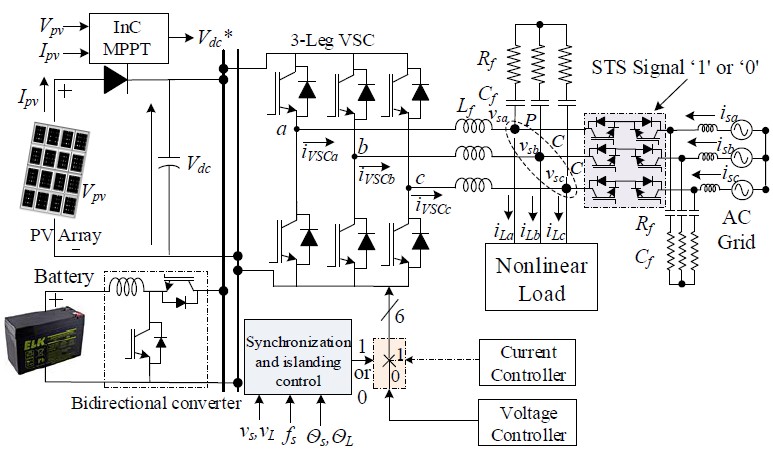Distributed Incremental Adaptive Filter Controlled Grid-Interactive Residential Photovoltaic-Battery Based Microgrid for Rural Electrification
Also Available Domains Microgrids|Hybrid Systems|Power Quality
Objective
The main objective of this project is to provide continuous supply to the emergency loads, harmonics mitigation, load balancing and power factor improvement.
Abstract
In this project, a Distributed Incremental Adaptive Filter (DIAF) controlled utility interfaced Photovoltaic (PV) - battery microgrid system is presented with power quality features. From protection aspects, grid tied solar inverters are required to shut down at loss of the utility. However, the multi-purpose PV-battery system is developed to provide energy to the critical loads, even at loss of distribution network.
The bidirectional controlled converter with a battery also mitigates the intermittency of a PV array under rapid variations in the weather. The extracted maximum power is supplied to the Voltage Source Converter (VSC), which is transferred to the nonlinear loads and the utility. The distributed incremental adaptive filter is used to control the VSC with contribution of PV power and the battery. In addition, the DIAF control provides harmonics mitigation, load balancing and power factor improvement functionalities in order to deal with system connected with nonlinear loads.
A PV Power Feed-Forward (PVFF) term is incorporated in the current control for injection of active power to the utility as well as to improve the dynamic operation of residential PV-battery microgrid. The Battery Energy Storage (BES) reduces the fuel bills and it is also utilized to provide smoothing attributes to the microgrid.
Keywords: PV-battery microgrid, power quality and distributed incremental adaptive filter.
NOTE: Without the concern of our team, please don't submit to the college. This Abstract varies based on student requirements.
Block Diagram

Specifications
Software Configuration:
Operating System : Windows 7/8/10
Application Software : Matlab/Simulink
Hardware Configuration:
RAM : 8 GB / 4 GB (Min)
Processor : I3 / I5(Mostly prefer)
Learning Outcomes
- Introduction to Matlab/Simulink
- What is EISPACK & LINPACK
- How to start with MATLAB
- About Matlab language
- About tools & libraries
- Application of Matlab/Simulink
- About Matlab desktop
- Features of Matlab/Simulink
- Basics on Matlab/Simulink
- Introduction to Distribution Generation
Systems
- Introduction to Renewable Energy Sources
- Introduction to Solar Power System
- Introduction to MPPT.
- Introduction to MicriGrids
- Introduction to distributed incremental
adaptive filter(DIAF)
- Introduction to PV power feed-forward
(PVFF) term
- Introduction to Types of Batteries.
- Introduction to Battery energy Storage
(BES).
- Introduction to Point of Common Coupling
(PCC)
- Introduction to Pulse Width Modulation
(PWM),
- Design of Solar Panel.
- How to
implement boost converter control?
- We can learn about the Grid
Synchronization and Islanding Control
- Introduction to open loop and closed
loop control system
- Introduction to bidirectional converter
- Introduction to RC Filters
- Introduction to Voltage Source
Converters (VSC)
- We can learn about PI Controllers
- We can learn about different types of
loads.
- We can learn about Mathematical model of
Solar panel
- Project Development Skills:
- Problem analyzing skills
- Problem solving skills
- Creativity and imaginary skills
- Programming skills
- Deployment
- Testing skills
- Debugging skills
- Project presentation skills
- Thesis writing skills


 Paper Publishing
Paper Publishing
